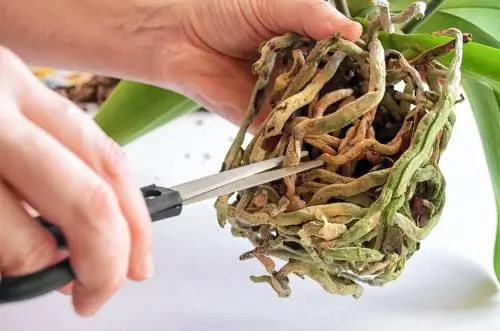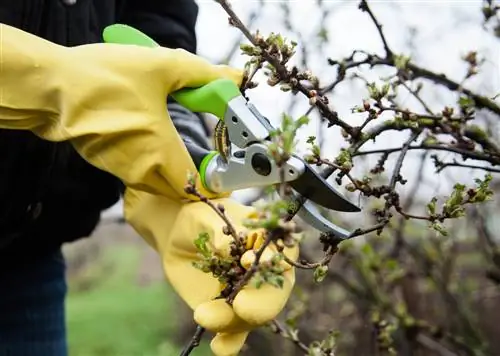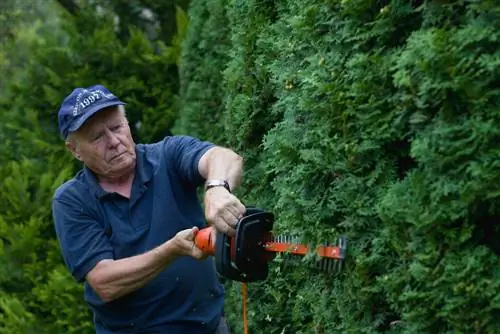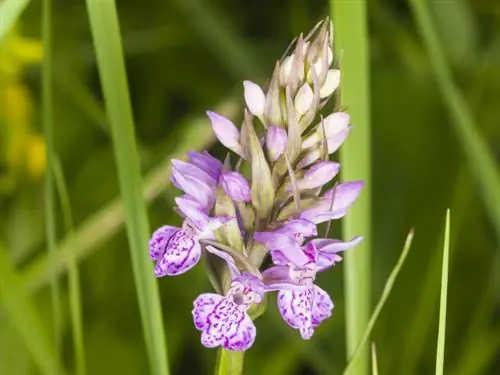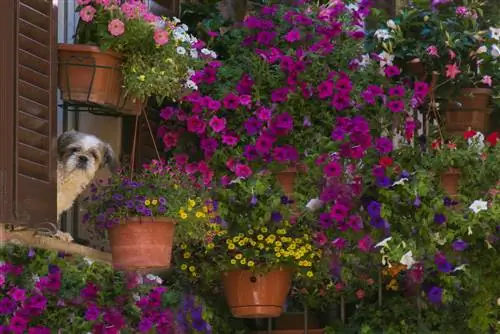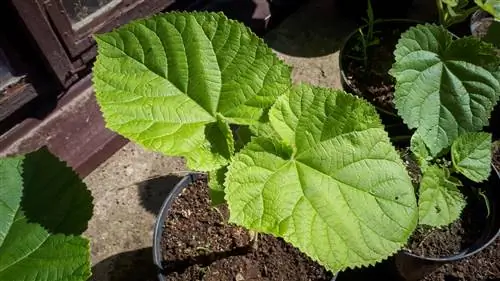- Author admin [email protected].
- Public 2023-12-16 16:46.
- Last modified 2025-06-01 06:02.
How often you should cut your orchids depends primarily on the species. Given that there are almost 30,000 species of orchids, this could be confusing and tricky for hobby gardeners. It's a good thing that there are comprehensible basic rules for cutting care. Read this tutorial about when and how to properly prune your orchids.
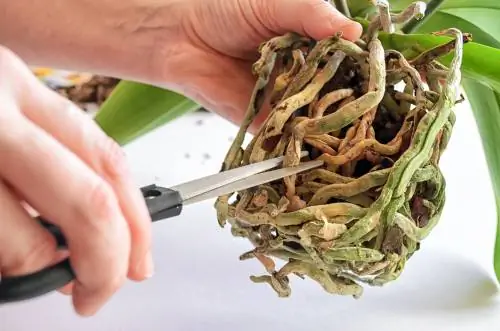
Cutting single-shoot orchids
Some of the most beautiful orchids for living spaces thrive on a single shoot. These species include the furious Dendrobium, also known as grape orchids. The tropical beauties only display their flowers once on each shoot. This makes cutting care incredibly easy. This is how you prune single-shoot orchids in an exemplary manner:
- The best time is after all the withered flowers have been shed
- Take a sharp knife or bypass scissors
- Cut off the dead shoot 1 to 2 cm above the base
Are you worried about cutting off a leafless and flowerless stem? Then just wait until the orchid pulls in the shoot from the tip to the base. Removing completely dried plant parts also reduces the risk of infections and pest infestation to a minimum.
Cutting multi-shoot orchids
If orchids grow with multiple shoots, special pruning is required. This category includes Phalaenopsis species and varieties, the undisputed leaders in the ranking of popular houseplants. Furthermore, magnificent Venus slippers (Paphiopedilum) and various Oncidium species appear as multi-shoot orchids. This is how you complete the perfect cut care:
- Wait for dead flowers to drop
- Cut back dead stems by a third
- Ideal intersection point: just above the 2nd or 3rd eye from below
A green stem can surprise you with new flowers up to three times. However, some orchids challenge the gardener's patience. Depending on the location and time of year, several months pass before new buds develop. After reassembling three times, the flower festival is finally over. The entire shoot dries up and can be removed at the base.
Revolver bloomers - non-stop blooms
A short excursion into their botanical attributes will illustrate why the orchid species mentioned benefit from the recommended pruning care. Phalaenopsis or Oncidium are called revolver bloomers. The orchids produce their flowers tirelessly, as if shot from a gun. Once a bud has developed on the stem, the shoot grows a little further to present the next flower bud. Under ideal conditions, the flowering period extends over months or years. Where a shoot is juicy green, there is a good chance that buds and flowers will soon form.
Background
Cut activates dormant buds
It is not reserved for trees and bushes to create several sleeping eyes as floral reserves. Popular orchids such as Phalaenopsis and Dendrobium also have the ingenious ability. Dormant buds are usually located below the lavish flower spikes. Recognized as a slight thickening along the stem, dormant buds are usually activated by making a cut. By cutting off spent panicles, a sap is created, which acts as a wake-up call for the tiny buds.
Always cut off dried flower stems
One basic rule applies regardless of whether it is a single-shoot or multi-shoot orchid: always cut off dried stems.
Once a former flower stem is brown and dry, floral life will never pulsate there again. Without hesitation, cut the stem at the base. Have you discovered a brown, dried-out side shoot on the green main shoot? Then please only cut off the dead part and leave the green main shaft. With good care, there is a good chance that the orchid will decide to bloom at this point.
Cutting rotten orchids
With a few flowers here and there, neglected orchids are a shadow of their former selves. In contrast to their magnificently flowering counterparts, acut into green shoots can now be advantageous. By boldly cutting off the damaged stems, you can breathe new life into a rotten orchid. Place scissors or knife at the base of the shoot.
The cut clears the way for a new, strong flower stem. In addition, we recommend a well-measured dose of orchid fertilizer with valuable nutrients.
Tip
Orchids cannot tolerate conventional flower fertilizer. The high s alt content makes it difficult for the epiphytic flowers. By administering a special orchid fertilizer, you can get the exotic flower festival going after a vitalizing cut. Liquid fertilizers are well suited because they are simply added to the irrigation or immersion water every 14 days. You should not fertilize your orchids during the dormant phase.
It's better to pluck out wilted leaves
Orchid leaves are generally not cut. As natural aging occurs, individual leaves turn yellow, shrivel and dry out. You should not intervene in the process because remaining nutrients are relocated to the roots. Only when a leaf has completely died can it be removed. How to proceed professionally:
- Juicy green leavesdo not tear off or cut off
- Remove retracted, unmistakably dead orchid leaves
- Grasp the leaf between your thumb and index finger and release it with a slight pull
Leaf damage to orchids can occur for a variety of reasons. Sunburn, cracks due to dryness and heat accumulation on the south window are among the most common causes. As long as the damage is limited to local areas and does not spread further, a leaf should not be removed. Any cut into he althy leaf tissue attracts pathogens that use cuts as a welcome portal of entry.
Excursus
Taking a breather is normal
It is not uncommon for orchids to take a break after being cut. For a few weeks the flower beauties simply show no sign of life. This is no cause for alarm. Rather, the rest signalizes that the exotic flower is in a phase of regeneration. Over the course of a few weeks or months, popular orchid species and varieties gather fresh energy for renewed flowering. Do not throw away Phalaenopsis and other species that appear to be dead. Water less and do not apply fertilizer until a new flower stalk emerges.
Cleaning out root balls
Orchids should be repotted every two to three years. Changing to fresh substrate and a larger pot revitalizes flowering in the long term. If the root network is lying on the table without any substrate, prudent gardeners will not miss the opportunity for a thorough cleaning. How to clean orchid roots skillfully:
- Unpot the orchid, shake off or rinse the substrate
- Cut out rotten brown, soggy roots
- Stabilize the affected root with one hand
- Take the knife or scissors in your other hand and cut off smoothly
Do you feel forced to cut out several roots with white coating or black spots from the weave? Then please take special care because fungal pathogens are rampant. Disinfect the blade with rubbing alcohol after each cut to prevent spores from being transferred to he althy tissue.
Finally, place the cleaned root ball in a new culture pot with fresh orchid soil. If the previous container offers enough space for the reduced root network, it should first be cleaned with hot water and Sagrotan.
Tip
Are you struggling with stubborn aerial roots when repotting? Then give the stubborn root strands a warm water bath. Submerge the roots in soft, room temperature water for a few minutes. The aerial roots are pleasantly flexible for a short time and can be integrated into the pot and substrate.
Cut aerial roots - when and how?
When orchids with long aerial roots gesture in all directions, worried indoor gardeners hastily reach for scissors. The long tentacles are often perceived as unaesthetic and annoying. A cut needs to be carefully considered, because aerial roots fulfill important tasks. The following overview summarizes the conditions under which a cut makes sense:
- He althy, juicy aerial rootsdo not cut crosscut
- Cut off damaged, diseased, dried or dead root strands
- Cut away softened roots covered in black dots at the base
It sometimes takes a trained eye to distinguish he althy from diseased or dead aerial roots. A silvery-white, dried root is not always actually devoid of life. A moisture test clears up any final doubts. Spray the orchid root in question with decalcified water and wait a few minutes. If the aerial root turns green, it is not a case for the scissors. However, there is no doubt about the need for cutting when it comes to rotten-brown root strands.
Cut off rooted childel
Phalaenopsis amaze us when new leaves and tiny roots sprout from the top of the dead shoot. This is how old orchids like to produce their offspring. Epidendrum, Dendrobium and Calanthe also delight with their floral phenomenon. Orchid gardeners also refer to the Kindel as Keiki. If you rush to grab a knife or scissors, you are depriving yourself of the joy of a new butterfly orchid. When and how to cut an orchid keiki is summarized in this overview:
- Wait until at least 2 leaves have sprouted and roots are 2-4 cm long
- Until then, support the shoot with Keiki with a stick
- Perform normal care program
- Best time of year for separation is spring
- Cut off the kindle and pot it up
It is not absolutely necessary to separate the mother plant and the offshoot. As long as both thrive he althy and vital, the orchid duo offer a picturesque spectacle when they are in bloom. If the stem on which a keiki is standing turns yellow, you cannot avoid making a separate cut.
Cut garden orchids like perennials
In the natural garden, hardy orchid species shine with their lush flowers well into autumn. In contrast to sensitive indoor orchids, orchids, orchids, stendelwort and yellow lady's slipper have adapted well to the Central European climate. When it comes to pruning care, the rules are similar to those for native perennials. How to cut garden orchids correctly:
- The best time is before the first frost
- Only cut off leaves and shoots when they are dead
- Cut back garden orchids in pots at ground level and put them away
Please do not leave any clippings lying around in the bed. Pathogenic pathogens like to use the fleshy leaves as winter quarters. A protective layer of leaves and brushwood is recommended to drain winter moisture away from the roots.
Treating cuts
Cut wounds on orchids provide an ideal target for germs, bacteria and fungal spores. The risk also exists if you cut a dead stem. You slow down cunning pathogens and pests by treating open wounds promptly. The following home remedies have proven to be effective in practice:
- Dab cuts with pure charcoal ash
- Alternatively dust with cinnamon
Unless you are using a charcoal grill, purchase activated charcoal powder. Also known as medical charcoal, numerous drugstores and he alth food stores offer the black powder at an affordable price. Activated carbon powder is made from organic substances and is useful as a cleaning agent, in men's cosmetics and to prevent all kinds of infections. Applied to cuts on herbaceous plants, the agent acts like a bulwark against pathogenic pathogens.
Tools for Orchid Gardeners
With the right tools and accessories, you can concentrate undisturbed on making the right cut on orchids. The top priority for professional pruning care on orchids is the use of sharp and clean cutting edges. The basic equipment consists of the following components:
- Sharp knife or scalpel
- Handy scissors as bypass scissors with two sharp cutting edges
- methylated spirits and rag or candle and lighter
Do not use knives or scissors until the blades have been freshly sharpened and free of germs. Denatured alcohol or Sagrotan are suitable for disinfecting. To be on the safe side, you briefly hold the cutting edge in a candle flame and let it cool down.

Frequently asked questions
My orchid has sticky leaves. Should I cut them off?
Sticky leaves signal that your orchid is under stress. The most common causes are too dry air in the living space and aphids. Strong temperature fluctuations, such as near tilted windows, also cause the damage. A sticky coating is no reason to cut off the leaves. Wipe each sheet with a soft cloth. Spray orchid leaves regularly with room temperature, lime-free water and avoid massive temperature fluctuations in the immediate vicinity of the location. You can fight aphids with the classic soft soap solution made from 1000 ml of lime-free water and 1 tablespoon of soft soap.
What do I do with dead flower stems?
As a rule, you can cut off spent panicles on orchids quite deeply. An exception applies to multi-shoot orchids, such as Phalaenopsis. Species and varieties of this genus should be pruned differently because they can bloom again on dead stems. Shorten the stems in question by a third. Ideally, the cut above the second or third eye is made with a sharp, disinfected knife.
Can I cut off aerial roots when repotting my orchid?
You can cut off annoying aerial roots. Please reduce the amount of cutting to a minimum, as aerial roots turn into earth roots when they come into contact with the substrate. In this form they make a valuable contribution to the water and nutrient supply of leaves and flowers. Therefore, when cutting and repotting, make sure that the pot is one size larger than before. Soak aerial roots in lukewarm water. This means they are supple enough to be placed in the culture pot.
After 3 years of magnificent flowering and he althy growth, my Phalaenopsis is getting wilted, limp leaves. Should I cut off the leaves?
When Phalaenopsis leaves become soft and limp, it is usually a normal aging process. This is especially true if the foliage also turns yellow and the lower leaves are affected. However, if all the leaves wilt at once, it is a care problem. After 3 years, the substrate is heavily compacted and leached so that roots are no longer fully functional. Repot the orchid. Take this opportunity to only remove those leaves that can be pulled off without using force.
The roots on an orchid turn brown, but are still firm. What can be the cause? Should I cut off the roots?
Orchid roots will turn brown but remain solid if you use water with too high a s alt concentration for watering. A clear symptom of this cause is when the roots further down in the substrate are little or not at all discolored. Under no circumstances should you cut off the brown, firm roots. The damaged parts can regenerate if you water immediately with low-lime water and apply an extra low-s alt fertilizer.
My butterfly orchid has such a magnificent inflorescence that the stem lies on the ground. What to do?
Two options are available to solve the problem. To stabilize the flower stem, insert a wooden stick into the pot. You attach the overloaded shoot to this in several places. Use a soft, flexible binding material that will not cut into the plant tissue. As a second option, you can cut off the beautiful flower stalk and place it in a vase. In a partially shaded location, the flowers will last a long time if you change the water regularly.
The 3 most common cutting mistakes
Serious pruning errors leave a battered orchid without flowers. In the worst case, the royal flower beauty dies completely. To protect you from the floral nuisance, the following table summarizes the three most common mishaps and has tips for skillful prevention:
| Cutting errors | malicious image | Prevention |
|---|---|---|
| green stems and leaves cut off | no flowers, total failure | only cut dead plant parts |
| all aerial roots cut off | Growth depression, loss of flowering period | remove as few aerial roots as possible |
| Orchid leaf partially cut | brown, rotten leaf edge, spread of diseases | Never cut orchid leaves piece by piece |
Tip
If orchids rigorously keep their flowers under wraps, a slight reduction in temperature will help. Popular species, such as wonderful Phalaenopsis and opulent Dendrobium, respond positively to an environment that is 3 to 5 degrees Celsius cooler. Flower induction will begin within six weeks, provided all other conditions are right.

